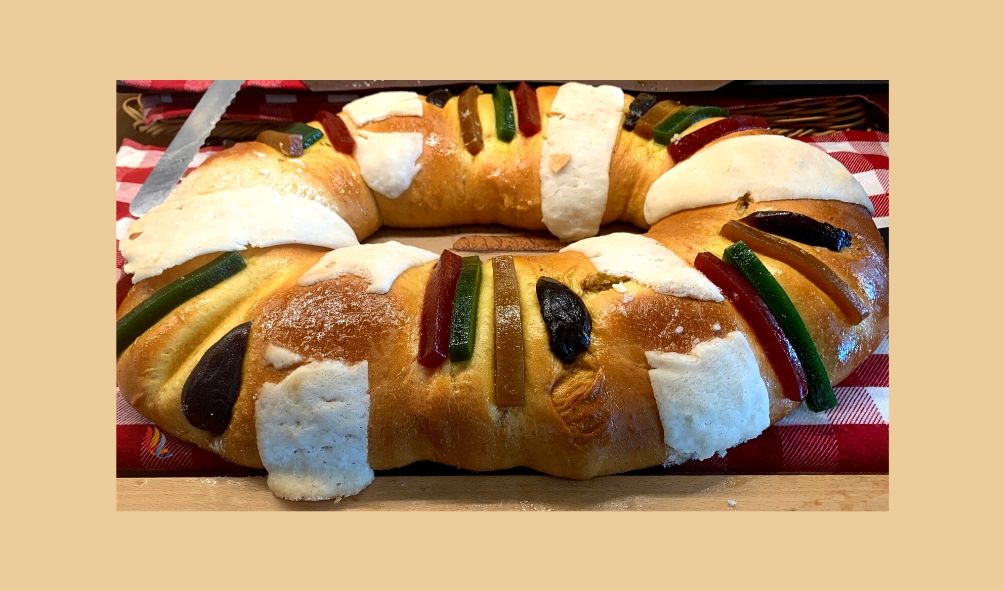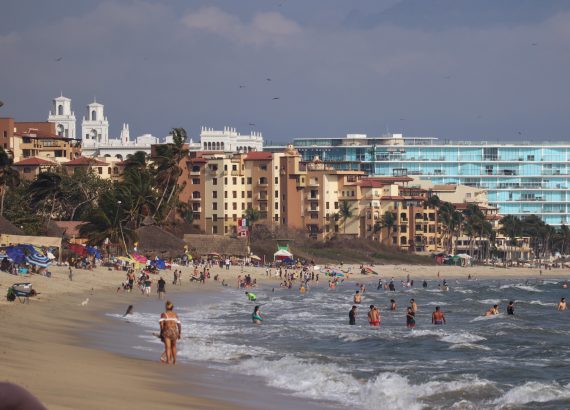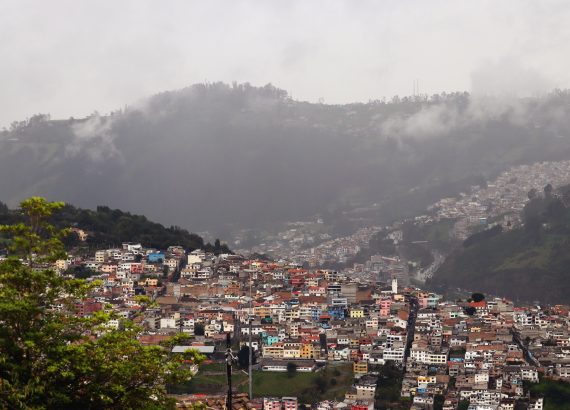Rosca de Reyes,”….a Traditional Recipe for Celebrating Three Kings Day
This year’s pandemic holidays may tempt some of us to do something slightly different such as celebrating traditions common on Three Kings’ Day (“El Dia de los Reyes”). So what exactly are some of these traditions?
First of all, a bit of history. For many throughout the world, the holiday season officially ends on January 6th, twelve days after Christmas, known as the Feast of the Epiphany, or Three Kings’ Day, when three wise (rich) men ended their search bringing gifts to baby Jesus. This holiday of gift-giving is celebrated all over Europe, Latin countries and has been steadily growing in the US among Latinos and other cultures.
For most (not all) this holiday, which includes gift-giving, is also celebrated with a special cake baked for this occasion. It’s interesting to see the different ways that countries celebrate this cake tradition that began in France. For instance, the gâteau des rois is a sweet brioche bread topped with candied fruit and sugar, including a trinket; whoever finds it inside their slice of cake will become king or queen for the day.
In Mexico, as in many Latino countries and southwestern states, the cake is celebrated with families and friends only on Jan. 6 along with the gifting of toys to children. Whoever gets the baby Jesus trinket baked in the cake has to host a tamales party during the first week of February, which is “ El Dia de Candelaria,” a day of church-going and visiting family.
Mexicans refer to the sweet cake as “Rosca de Reyes,” or King’s Cake. “Rosca” means wreath, and “Reyes” refers to kings. As seen in the photo, The Rosca de Reyes has an oval shape to symbolize a crown with dried and candied fruits to symbolize the many jewels that a crown would have. The trinket baked in the cake symbolizes the hiding of the infant Jesus from King Herod’s troops.
The Three King celebration in the Caribbean islands(Puerto Rico, Cuba, Santo Domingo) does not do the cake thing; however, why not adopt such a lovely tradition during the holiday (well, maybe minus the tamales).
The most popular version of all King’s Cake celebration is held in New Orleans, where eating this sweet bun starts on Jan. 6 and continues through the Mardi Gras festivities ending with Fat Tuesday and, in some cases, longer. In fact, the King’s Cake with its purple, gold, and green frosting has become an essential iconic symbol for the Mardi Gras festivities and the city of New Orleans and as such has become a significant moneymaker now that the cake is eaten during other celebrations and events such as football (so much for tradition).
Looking to celebrate Three Kings Day this coming year? (Why not? what else is there to do during Covid?) If so, I found this recipe for baking this sweet bun Latino style. Don’t forget to buy the baby Jesus trinket as a blessing in the new year.
Rosca de Reyes (Three Kings Bread) Recipe
Makes 8 to 12 servings
Rosca de Reyes is sometimes compared to the king cake used to celebrate Mardi Gras in New Orleans, though it is different. Adapted from the Food Network, this recipe kneads candied fruit into the dough, but roscas tend to be bare inside. If you want to go authentic, reserve the fruit for the top only.
Ingredients• 1 (1/4-ounce) packet active dry yeast, or 2 1/4 teaspoons loose yeast• 1/4 cup warm water• 1/4 cup dried figs, cut into strips, plus more for garnish• 1/4 cup candied orange peel, cut into strips, plus more for garnish• 1/4 cup candied lemon peel, cut into strips, plus more for garnish• 1/4 cup chopped candied cherries, plus more whole for garnish• 2 tablespoons light rum• 1/4 cup milk• 1/4 cup sugar• 1/4 cup (1/2 stick) unsalted butter• 1 teaspoon pure vanilla extract• 1/4 teaspoon ground cinnamon• 1 teaspoon salt• 3 1/2 to 4 cups all-purpose flour• 3 large eggs, divided (but not separated)• Water.
Instructions
In a small bowl, combine the yeast and warm water; stir to blend. Let stand until the mixture foams, about 5 to 10 minutes.
In another small bowl, put all the candied fruit and drizzle with the rum. Let stand for 15 minutes to 1 hour to soak up the flavor.
In a small pot, warm the milk over medium heat. Add the sugar, butter, vanilla, cinnamon, and salt.
In a large bowl, mix 3 1/2 cups flour, 2 eggs, yeast mixture, milk mixture, and the rum-soaked candied fruits, mixing very well until the dough gathers into a ball. If the dough is too wet, add additional flour, a little at a time, to form a soft dough. Turn the dough out onto a lightly floured surface and knead until it’s smooth and elastic, about 5 minutes. Put the ball of dough back into the bowl and cover with plastic wrap or a kitchen towel, and set aside in a warm spot to rise for 1 hour.
Remove the dough from the bowl and knead on a lightly floured surface. Using your palms, roll the dough into a long rope. Shape the rope into a circle, sealing the ends together. Insert a little doll or coin into the bread from the bottom, if desired (make sure you tell people it’s in there, so no one chokes). Line a baking pan with parchment paper. Carefully transfer the dough ring to the prepared baking pan.
Preheat the oven to 350 F.
Beat the remaining egg in a small bowl with 1 tablespoon of water to make an egg wash, and brush the top of the bread. Decoratively garnish the top of the bread with more candied fruit and bake for 35 to 40 minutes until the cake is golden.
Cool on a wire rack before slicing.
The photo of the Rosca was taken in Nuevo Vallarta in Mexico during Epiphany week.





LbgkeynC
dapoxetine super viagra getting viagra in malaysia viagra cialis melbourne site:au [url=http://genqpviag.com/]viagra without prescription australia[/url] ’
JdbxkeynC
is viagra over the counter the cheapest online viagra professional vs super active viagra [url=http://llviabest.com/]viagra on line australia[/url] ’
LbsxkeynC
AhkdkeynC
hair loss pharmacy uk canada pharmacy no prescription
AqcfRataLauby
cialis hur mycket
[url=http://www.cialiseven.com/]purchase cialis in montreal[/url] cialis maximaldosis
rozdiel viagra cialis
efek cialis 50 mg
[url=https://dociali.com/]buy cialis for daily use[/url] original cialis online
FvfcArodo
buy viagra in melb viagra per nachname bestellen can i buy viagra over the counter in canada
AhbzkeynC
cash advance america ocala fl cash advance places in ypsilanti mi money loan formula
does cialis cause edema
JbbnkeynC
cialis one day costo can i take viagra with cialis
FqbbkeynC
payday loan stores uk cash loan assistance safe reliable payday loans
KndnWami
viagra and heart disease how does viagra work?
HaroldSwona
ссылка на hydra
Amymic
[url=http://reallevitra.com/]buy cheap generic levitra[/url]
Charleshalry
Доставка алкоголя якутск
Charleshalry
Доставка алкоголя якутск
Lisamic
[url=https://healthytbb.com/]where can i buy stromectol[/url]
Alvaronum
hydraruz зайти на гидру
NbmoArodo
brand levitra cialis viagra add to cart canadian online pharmacy no prescription cialis dapoxetine
Charleshalry
Доставка алкоголя якутск
Charleshalry
Доставка алкоголя якутск
Kiamic
[url=http://sildenafiled.com/]cheap sildenafil[/url]
Jasonmic
[url=http://cialisdisp.com/]buy cialis tablets[/url] [url=http://pillsenorx.com/]fluoxetine hcl 20 mg tablets[/url] [url=http://forcepills.com/]plaquenil drug[/url] [url=http://antibactabs.com/]azithromycin 250 mg price[/url] [url=http://cialisdt.com/]how to order cialis without a prescription[/url] [url=http://cialisuno.com/]cialis online without prescription[/url] [url=http://toptabstore.com/]clomid tablet india[/url] [url=http://sildenafilhow.com/]viagra super force[/url] [url=http://ycialis.com/]cheap cialis canadian[/url] [url=http://howtocialis.com/]daily cialis online[/url]
Alanmic
Kiamic
[url=http://drugsildenafil.com/]how much is 1 viagra pill[/url]
Amymic
[url=http://flagylpill.com/]where can i buy flagyl online[/url]
Judymic
Carlmic
[url=http://ondansetronzofran.com/]zofran cost uk[/url] [url=http://cialisdt.com/]cialis price uk[/url] [url=http://forcepills.com/]hydroxychloroquine 200 mg[/url] [url=http://zmedsearch.com/]furosemide 60 mg[/url] [url=http://howtocialis.com/]can you buy cialis over the counter[/url]
Denmic
Lisamic
[url=https://tkmeds.com/]can you buy clomid online[/url]
Marymic
Markmic
[url=https://antibactabs.com/]zithromax antibiotic[/url] [url=https://levitraorder.com/]levitra free shipping[/url] [url=https://sildenafiled.com/]how to buy viagra safely online[/url] [url=https://albendazolealbenza.com/]albendazole brand name india[/url] [url=https://cialisopp.com/]tadalafil pharmacy[/url] [url=https://forcepills.com/]plaquenil price[/url] [url=https://shopfmed.com/]how to get metformin without a prescription[/url]
Eyemic
[url=http://cialisoff.com/]cialis chew or swallow[/url] [url=http://cialisuno.com/]purchase cialis[/url] [url=http://levitrahow.com/]cheapest levitra uk[/url] [url=http://cialismedication.com/]avana 100 mg[/url] [url=http://btviagra.com/]female viagra over the counter[/url] [url=http://buyviagrap.com/]buy female viagra pills[/url] [url=http://dpptables.com/]online pharmacy search[/url] [url=http://depresspills.com/]seroquel 400 mg cost[/url] [url=http://tkmeds.com/]clomid online fast delivery[/url] [url=http://ddvrx.com/]phenergan cream 10g[/url]
Paulmic
[url=https://nexiumesomeprazole.com/]nexium 160 mg[/url] [url=https://anastrozolearimidex.com/]buy arimidex cheap[/url] [url=https://tkmeds.com/]buying from canadian pharmacies[/url] [url=https://levitraorder.com/]price of levitra in canada[/url] [url=https://shopfmed.com/]mail order pharmacy india[/url]
Lisamic
[url=https://toptabstore.com/]best over the counter clomid[/url]
Kiamic
[url=http://ddvrx.com/]pharmacy in canada for viagra[/url]
Judymic
[url=http://clppharm.com/]synthroid[/url] [url=http://imqpills.com/]celexa 40[/url] [url=http://xxlviagra.com/]female viagra price[/url] [url=http://sildenafiled.com/]cost viagra canada[/url] [url=http://buyimedications.com/]abilify[/url] [url=http://efftablets.com/]good value pharmacy[/url] [url=http://yasminrx.com/]yasmin tablet price in india[/url] [url=http://sildenafilhow.com/]female viagra pill canada[/url] [url=http://tkmeds.com/]clomid tablets for sale[/url] [url=http://enviagra.com/]sildenafil citrate 100mg tab[/url]
Amymic
[url=http://stoppainrem.com/]provigil india price[/url]
Carlmic
[url=http://clppharm.com/]synthroid 88[/url] [url=http://cialisdisp.com/]bluechew tadalafil[/url] [url=http://pllzshop.com/]best online pharmacy india[/url] [url=http://adatabs.com/]buy retin-a[/url] [url=http://oggpharm.com/]cost of cipralex daily[/url]
Kiamic
[url=http://ivermectinpharmacy.com/]order stromectol online[/url]
Lisamic
[url=https://btviagra.com/]buy viagra[/url]
Markmic
[url=https://dbbpharm.com/]plaquenil medication[/url] [url=https://adatabs.com/]retin a 0.01 buy[/url]
Amymic
Paulmic
[url=https://enviagra.com/]viagra online canada pharmacy[/url] [url=https://malegraonline.com/]malegra 200[/url] [url=https://conmstore.com/]reliable online pharmacy[/url] [url=https://iviagrabuy.com/]india pharmacy viagra[/url] [url=https://tabsildenafil.com/]sildenafil without prescription from canada[/url]
Amymic
[url=http://urbbpharm.com/]best online pharmacy reddit[/url]
Carlmic
[url=http://cymbaltapill.com/]buy cymbalta generic[/url] [url=http://anastrozolearimidex.com/]arimidex without a prescription[/url] [url=http://cialisrmp.com/]where to buy cialis in canada[/url] [url=http://cialisdisp.com/]tadalafil buy online india[/url] [url=http://cialisopp.com/]cheap cialis online india[/url]
Jasonmic
Eyemic
[url=http://cialisuno.com/]cialis canada generic[/url] [url=http://ivermectinpharmacy.com/]ivermectin[/url] [url=http://pillsenorx.com/]how to get zoloft online[/url] [url=http://skincaretab.com/]generic prednisone[/url] [url=http://forcepills.com/]plaquenil for sale[/url] [url=http://levitraorder.com/]best online pharmacy generic levitra[/url] [url=http://reallevitra.com/]vardenafil price in india[/url] [url=http://packcialis.com/]generic tadalafil 20mg for sale[/url] [url=http://enviagra.com/]viagra gel[/url] [url=http://shopfmed.com/]best online pharmacy reddit[/url]
Markmic
Kiamic
[url=http://tkmeds.com/]clomid coupon[/url]
Markmic
[url=https://okviagra.com/]viagra 100mg tablet price[/url] [url=https://cialisdt.com/]how much is cialis 20mg[/url] [url=https://reallevitra.com/]where can i buy levitra[/url] [url=https://cialismedication.com/]cialis pharmacy australia[/url] [url=https://howtocialis.com/]tadalafil 20 mg order online[/url] [url=https://pillsenorx.com/]generic wellbutrin online[/url]
Denmic
[url=http://hydrochlorothiazidehctz.com/]hydrochlorothiazide 10 mg[/url] [url=http://ntmhealth.com/]paroxetine 34mg[/url] [url=http://optablets.com/]where can i get erythromycin[/url] [url=http://ondansetronzofran.com/]buy generic zofran online[/url] [url=http://viagrabtab.com/]genuine viagra online usa[/url]
Buying An Essay
[url=http://homeworkhelpp.com/]research paper literature[/url] [url=http://domyhmw.com/]help with my accounting homework[/url] [url=http://iwritinghelp.com/]sites that write papers for you[/url]
Writing Essay Online
[url=https://homeworkhelpp.com/]good presentation[/url] [url=https://pprwriting.com/]write a literature review paper[/url] [url=https://domyhomeworkpls.com/]essay on helping poor[/url] [url=https://joessay.com/]order essay[/url] [url=https://essayinst.com/]academic writing from paragraph to essay[/url]
Online Essay
[url=http://homeworkhelpp.com/]online algebra help[/url] [url=http://esswrt.com/]writing a rhetorical analysis essay[/url] [url=http://homeworktnt.com/]help with writing and research papers[/url] [url=http://writingservicemoon.com/]best article writing services[/url] [url=http://domyhmw.com/]homework helpers[/url] [url=http://xstudyhelp.com/]buy essays online[/url] [url=http://iwritinghelp.com/]pay someone to write my assignment[/url]
Paulmic
[url=https://cialisorder.com/]cialis generic over the counter[/url] [url=https://sildenafiled.com/]viagra buy online canada[/url] [url=https://nexiumesomeprazole.com/]nexium tablets price[/url] [url=https://cleocinclindamycin.com/]cleocin t pledgets[/url] [url=https://xxlviagra.com/]viagra pills online canada[/url]
Kiamic
[url=http://viagrareva.com/]real viagra pills online[/url]
Jasonmic
[url=http://cialisorder.com/]generic tadalafil[/url] [url=http://depresspills.com/]atarax generic otc[/url] [url=http://shopfmed.com/]metformin 500 mg uk[/url] [url=http://ntmhealth.com/]prozac tablet[/url] [url=http://imqpills.com/]anafranil 75 mg[/url] [url=http://malegraonline.com/]malegra 200[/url] [url=http://conmstore.com/]online pharmacy without scripts[/url] [url=http://hydrochlorothiazidehctz.com/]hydrochlorothiazide coupon[/url] [url=http://xxlviagra.com/]mexico viagra over the counter[/url] [url=http://ondansetronzofran.com/]zofran generic coupon[/url]
Lisamic
Amymic
[url=http://antibactabs.com/]cipro medication[/url]
Jasonmic
[url=http://pllzshop.com/]which pharmacy is cheaper[/url] [url=http://imqpills.com/]best australian online pharmacy[/url] [url=http://pfhhealth.com/]finesterude no prescription[/url] [url=http://yasminrx.com/]yasmin canada[/url] [url=http://buyimedications.com/]top 10 pharmacy websites[/url] [url=http://cialisdt.com/]cheap online cialis[/url] [url=http://tbbstore.com/]generic cephalexin[/url] [url=http://viagraret.com/]where can you purchase female viagra[/url] [url=http://ddvrx.com/]medical pharmacy west[/url] [url=http://forcepills.com/]chloroquine for sale[/url]
Lisamic
[url=https://conmstore.com/]metformin 1000 mg price in canada[/url]
Hilda
I need to to thank you for this great read!! I absolutely loved every little bit of it.
I have got you book-marked to check out new
stuff you post…
Feel free to visit my web-site; Evangeline Huffstetler; Yetta,
Amanda
I like the valuable information you provide in your articles.
I’ll bookmark your weblog and check again here
regularly. I am quite sure I’ll learn lots of new
stuff right here! Good luck for the next!
Here is my website – Pennie Flenniken